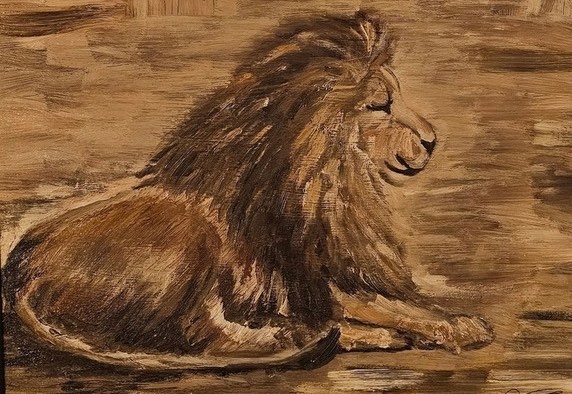Il linguaggio pittorico contemporaneo è variegato, presenta notevoli differenze sulla base del singolo artista, così come molteplici sono le interpretazioni dell’osservazione della realtà, in alcuni casi decisamente ermetica e introspettiva, in altri più orientata a rinunciare completamente all’estetica pur di scendere verso quelle profondità del sentire che mantenendo una forma armonica non potrebbero fuoriuscire, e poi ci sono quei creativi che invece hanno bisogno di indugiare sull’equilibrio tra il sentire e l’ammirare tutta quella delicata bellezza che avvolge l’esistenza e che troppo spesso viene soffocata dall’urgenza della contingenza. L’artista di cui vi racconterò oggi si lega imprescindibilmente alla contemplazione di ciò su cui il suo sguardo indugia, lasciando emergere le sensazioni più delicate e immediate, narrate con l’armonia estetica che contraddistingue la sua indole pittorica.
Quando alla fine dell’Ottocento un gruppo di artisti decise di stravolgere le regole sull’utilizzo del colore che fino a poco prima avevano predominato per secoli, non avrebbero mai immaginato che la loro eredità sarebbe stata raccolta, ampliata e modificata nel corso degli anni seguenti, perché ciò che davvero contava in quel momento era coniugare l’esigenza di dipingere all’aperto, eliminando così il disegno preparatorio e gli strati pittorici che dovevano essere eseguiti in studio, con il bisogno di trovare un modo per trasportare in modo agevole l’occorrente per dipingere, eliminando così la tavolozza. Utilizzare colori in tubetti prelevandovi direttamente con il pennello minime quantità che poi venivano poggiate con piccoli tocchi sulla tela permettendo alla vicinanza cromatica di definire quelle sfumature che a distanza riuscivano a rendere perfettamente la luce e l’atmosfera riprodotta, fu l’idea innovativa degli artisti fondatori dell’Impressionismo, pionieri di tutti quei successivi movimenti in cui il colore doveva essere utilizzato in maniera inconsueta, suddiviso e frammentato nell’esecuzione per poi ricomporsi nella retina dell’osservatore. Il Puntinismo, il Divisionismo, il Futurismo tesero, seppure in forme diverse, a rielaborare le teorie esecutive di quei pionieri che di fatto vollero porsi come antagonisti di un Realismo, ancora dominante nel Diciannovesimo secolo, troppo legato a un tipo di arte accademico e non più al passo con i tempi. Le opere di Claude Monet, di Auguste Renoir e di Edgar Degas, malgrado fossero ancora fortemente legate all’equilibrio estetico, cercando la perfetta resa della luce e dei dettagli rappresentati e dunque in qualche modo effettuando uno studio razionale sull’esecuzione del dipinto, non riuscivano a non lasciar trapelare la lirica vibrante degli scorci, dei paesaggi, dei momenti o degli interni, nel caso di Degas, che decidevano di immortalare. D’altro canto anche il Realismo nella stessa epoca cominciava a subire un’evoluzione in base alla quale gli artisti non si limitavano più alla ritrattistica bensì rivolgevano la loro attenzione all’esterno, a ciò che accadeva al di fuori dei palazzi nobili cercando di riprodurre scene di vita comune; questa tendenza sfociò, qualche decennio dopo, nel Realismo Americano in cui le linee guida del movimento furono oltrepassate e sovvertite grazie alla caratteristica degli artisti appartenenti a questo gruppo di infondere nelle tele la suggestione dell’introspezione e dell’osservazione, l’attenzione nei confronti di quel popolo che cominciava ad affollare le vie delle città mostrando una vitalità molto più interessante e appassionante rispetto agli ambienti aristocratici, o che, come in Edward Hopper, si ritrovava spesso a fare i conti con la propria solitudine. L’artista altoatesina Laura Pantarotto mostra l’attitudine a riprodurre la realtà osservata avvolgendo le sue opere dell’armonia lirica dell’Impressionismo senza però dimenticare l’esigenza di rimanere legata al disegno, che spesso emerge in modo visibile dalle sue tele e che contribuisce a evidenziare quei dettagli che con le pennellate larghe e frammentate vengono sfumati, resi impalpabili e leggeri.
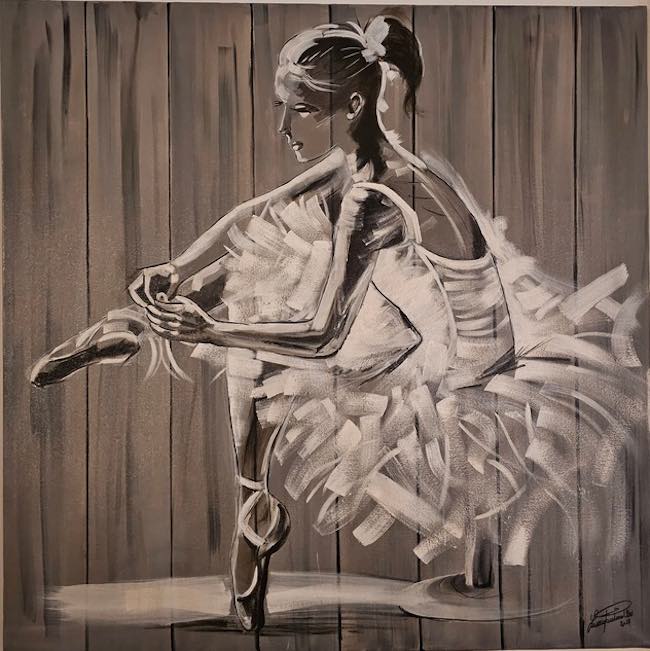
Una delle sue caratteristiche principali è quella di rivisitare completamente i due movimenti del passato a cui la sua pittura è riconducibile, il Realismo e l’Impressionismo, dando vita a un tratto pittorico vicino al Realismo nella resa dell’immagine e nella presenza del disegno, ma poi lo supera, spingendosi verso un Impressionismo rinnovato e personalizzato in cui la Pantarotto tralascia la tendenza alla totale scomposizione, quella che costringeva l’osservatore ad allontanarsi dalla tela per vedere con chiarezza l’immagine complessiva e più definita, e si sposta verso una suddivisione ottenuta con dei brevi tocchi di spatola, di fatto ingrandendo e stravolgendo il concetto di base degli impressionisti poiché nel suo caso la grandezza dei tocchi cromatici infonde un senso di indefinitezza, di impalpabilità dei soggetti narrati, avvolgendoli di quella suggestione morbida che ne caratterizza le opere.
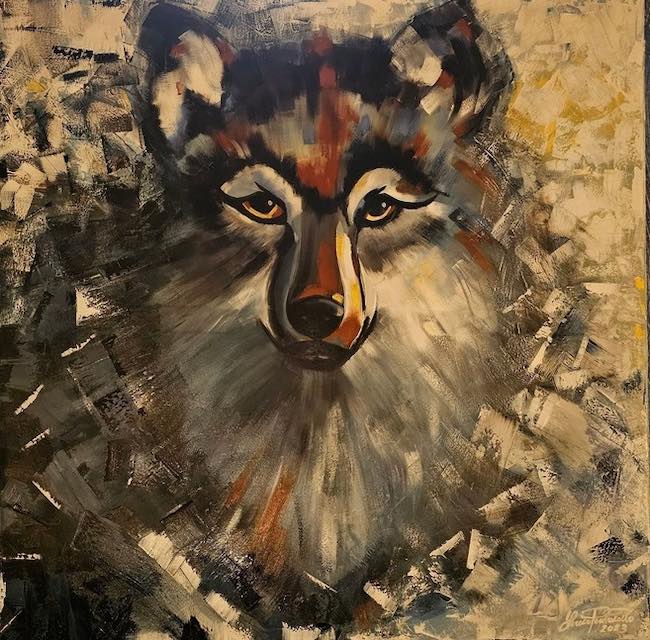
Il risultato è un’alternanza armonica tra poesia e approfondimento introspettivo, tra ciò che viene semplicemente visto e ciò che invece l’interiorità riceve nel momento in cui Laura Pantarotto ricorda quei dettagli che hanno colpito la sua attenzione e che poi desidera riprodurre sulla tela, mostrando le sue due anime divergenti eppure in grado di incontrarsi all’interno di un’unica personalità, quella di un’artista in equilibrio tra il lato più pragmatico e razionale legato alla professione in ambito bancario e il lato più sorprendentemente delicato e contemplativo che emerge nell’espressione pittorica trasformandosi in un momento magico in cui riesce a entrare nella dimensione più affine alla sua anima.
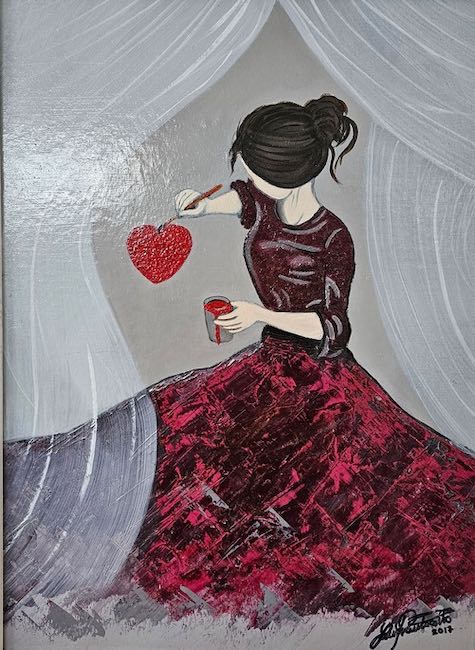
Fin da giovane mostra una forte attitudine al disegno, che resta alla base delle sue opere, come se l’apporto cromatico non fosse sufficiente a raccontare la morbidezza che la sua emotività coglie, come se, ancora una volta, il suo lato più sensibile avesse bisogno della delineazione del pragmatismo per elevarsi da esso.
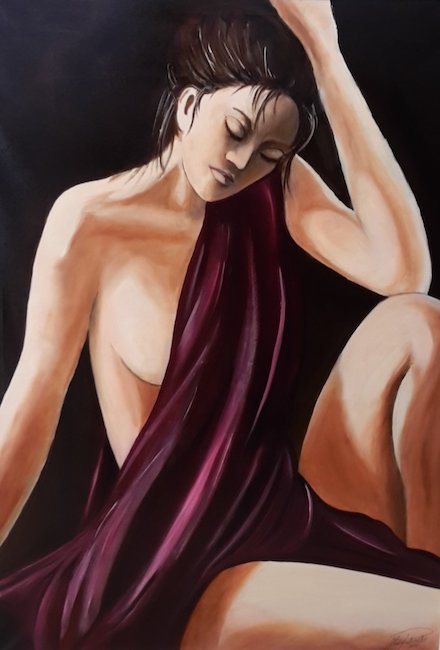
Il suo punto di vista sul mondo e su tutto ciò che ne fa parte è romantico, etereo e orientato a dare risalto alla bellezza che troppo spesso nel vivere contemporaneo tende a sfuggire a causa proprio di quella razionalità che in lei trova realizzazione nel lato professionale; pertanto nell’arte Laura Pantarotto lascia che lo sguardo si soffermi su tutto ciò che non può essere visto con gli occhi, ascolta le energie che suo il ricco mondo interiore riceve e poi le trasforma in opera pittorica in cui emerge in maniera decisa e intensa tutto quell’equilibrio estetico, quella melodia silenziosa che fuoriesce da un’osservazione empatica nei confronti di un’essenza apparentemente invisibile eppure fortemente presente.
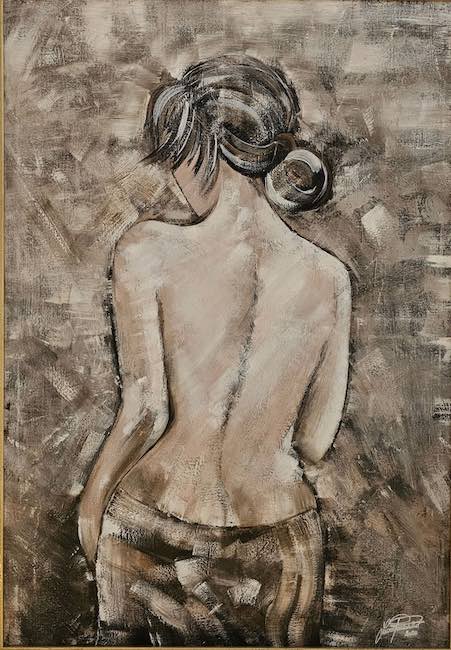
Perché in fondo la poesia si nasconde nelle piccole cose ma soprattutto si svela a chi è in grado di ampliare il proprio punto di vista da ciò che può essere guardato distrattamente a ciò su cui è necessario indugiare se si vuole permettere all’interiorità di lasciarsi avvolgere dalle sensazioni, di emozionarsi e porsi in contatto con quanto va oltre l’immagine, con quel dialogo silenzioso che parte dalla bellezza della natura e giunge a far vibrare le corde più profonde. La sua empatia si manifesta in modo evidente quando posa il suo sguardo sugli animali così come al mondo femminile di cui diventa narratrice di passione, determinazione, fragilità che la donna riesce sempre a trasformare in forza; questo è il motivo per il quale le sue protagoniste sono spesso ritratte di schiena o concentrate a compiere quei piccoli gesti che arricchiscono la loro quotidianità ed evidenziandone la delicatezza.
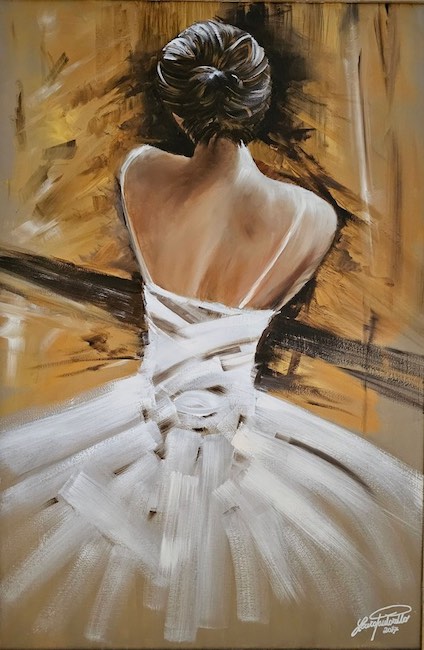
È un approccio lento, meditativo, lirico, quello della Pantarotto nei confronti dei suoi soggetti ma in particolar modo della sua amata arte, quel mondo sospeso dove può ritrovare se stessa, la sua vera essenza, perché attraverso il gesto pittorico è in grado di aprirsi completamente per mostrare le emozioni più profonde, quelle attraverso le quali riesce a entrare in connessione con gli animali che ama immortalare, e di cui mette in evidenza non la pericolosità bensì l’animo profondamente puro che induce l’osservatore a notarne la naturalezza e la serenità con cui vivono nel loro contesto naturale.
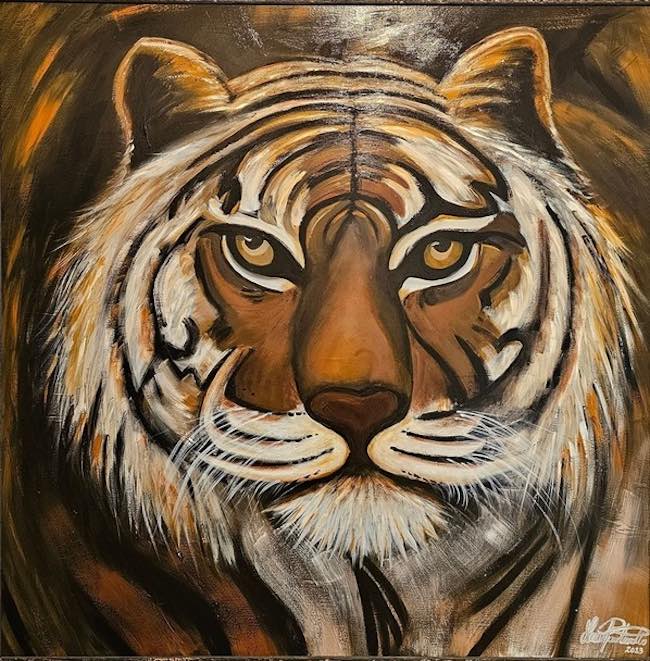
Attualmente il percorso artistico di Laura Pantarotto si sta concretizzando con mostre collettive sia sul territorio nazionale che in quello internazionale, ha al suo attivo numerose mostre personali e collettive in Italia e all’estero – Londra, Parigi e Barcellona – dove riceve consensi da parte del pubblico e degli addetti ai lavori. È stata selezionata per partecipare nei prossimi mesi alla Usa Biennal 2023/2024 che vedrà le sue opere esposte a Miami, Los Angeles, New York, Washington, ed è socia del Club Arcimboldo di Bolzano e dell’Associazione Artisti Alto Adige.
LAURA PANTAROTTO-CONTATTI
Email: laura.pantarotto74@gmail.com
Sito web: www.laurapantarotto.it
Facebook: https://www.facebook.com/laura.pantarotto.7
Instagram: https://www.instagram.com/lau_paint/
Laura Pantarotto’s Impressionist Realism, the beauty that emerges from simplicity
Contemporary pictorial language is variegated, presenting considerable differences on the basis of the individual artist, just as manifold are the interpretations of the observation of reality, in some cases decidedly hermetic and introspective, in others more oriented toward renouncing aesthetics completely in order to descend to those depths of feeling that by maintaining a harmonic form could not escape, and then there are those creative artists who instead need to linger on the balance between feeling and admiring all that delicate beauty that envelops existence and that is too often stifled by the urgency of contingency. The artist about whom I will tell you today is inescapably linked to the contemplation of that on which her gaze lingers, allowing to emerge the most delicate and immediate sensations, narrated with the aesthetic harmony that distinguishes her painterly nature.
When at the end of the nineteenth century a group of artists decided to upset the rules on the use of color that had until recently predominated for centuries, they never imagined that their legacy would be picked up, expanded and modified over the following years, because what really mattered at that time was to combine the need to paint outdoors, thus eliminating the preparatory drawing and pictorial layers that had to be done in the studio, with the need to find a way to easily transport the painting supplies, thus eliminating the palette. Using colors in tubes by taking directly from them with the brush minute amounts that were then placed with small touches on the canvas allowing the chromatic proximity to define those nuances that at a distance were able to perfectly render the light and atmosphere reproduced, was the innovative idea of the artists founder of Impressionism, pioneers of all those later movements in which color had to be used in an unusual way, subdivided and fragmented in execution and then recomposed in the retina of the observer. Pointillism, Divisionism, and Futurism tended, albeit in different forms, to rework the executive theories of those pioneers who in fact wanted to pose as antagonists to a Realism, still dominant in the 19th century, too closely tied to an academic type of art that was no longer in step with the times. The artworks of Claude Monet, Auguste Renoir and Edgar Degas, despite the fact that they were still strongly tied to aesthetic balance, seeking the perfect rendering of the light and details depicted and thus somehow carrying out a rational study of the execution of the painting, could not fail to let the vibrant lyricism of the views, landscapes, moments or interiors, in the case of Degas, that they decided to immortalize, seep through. On the other hand, Realism in the same era was also beginning to undergo an evolution whereby artists no longer limited themselves to portraiture but turned their attention to the outdoors, to what was going on outside the noble palaces, trying to reproduce scenes of ordinary life; this trend blossomed, a few decades later, into American Realism in which the guidelines of the movement were transcended and subverted thanks to the characteristic of the artists belonging to this group to infuse their canvases with the suggestion of introspection and observation, attention to the people who were beginning to crowd the streets of cities showing a vitality far more interesting and exciting than in aristocratic circles, or that, as in Edward Hopper, often found itself coming to terms with his loneliness. The South Tyrolean artist Laura Pantarotto shows an aptitude for reproducing observed reality by enveloping her artworks in the lyrical harmony of Impressionism without, however, forgetting the need to remain tied to drawing, which often emerges visibly from her canvases and helps to highlight those details that are blurred, rendered intangible and light with broad, fragmented brushstrokes. One of her main characteristics is that of completely revisiting the two movements of the past to which her painting can be traced, Realism and Impressionism, giving rise to a pictorial trait close to Realism in the rendering of the image and the presence of drawing, but then surpassing it, pushing towards a renewed and personalized Impressionism in which Pantarotto omits the tendency towards total decomposition, the one that forced the viewer to move away from the canvas in order to see clearly the overall and more defined image, and moves toward a subdivision obtained with short touches of the palette knife, in fact enlarging and distorting the basic concept of the Impressionists since in her case the size of the chromatic touches infuses a sense of indefiniteness, of impalpability of the subjects narrated, wrapping them with that soft suggestion that characterizes the artworks. The result is a harmonious alternation between poetry and introspective insight, between what is simply seen and what instead the interiority receives in the moment when Laura Pantarotto remembers those details that caught her attention and that she then wishes to reproduce on canvas, showing her two divergent souls yet able to meet within a single personality, that of an artist balanced between the more pragmatic and rational side related to her profession in banking and the more surprisingly delicate and contemplative side that emerges in her pictorial expression turning into a magical moment in which she is able to enter the dimension most akin to her soul. From a young age she shows a strong aptitude for drawing, which remains the basis of her paintigs, as if the chromatic contribution was not enough to tell the softness that her emotionality captures, as if, once again, her more sensitive side needed the delineation of pragmatism to rise from it. Her point of view on the world and everything in it is romantic, ethereal and oriented to emphasize the beauty that too often in contemporary living tends to escape because of the very rationality that in her finds fulfillment in the professional side; therefore in art Laura Pantarotto lets the gaze linger on everything that cannot be seen with the eyes, listens to the energies that her rich inner world receives and then transforms them into pictorial works in which all that aesthetic balance, that silent melody that emerges from an empathetic observation towards an apparently invisible yet strongly present essence, emerges decisively and intensely. Because after all, poetry is hidden in the small things but above all it reveals itself to those who are able to broaden their point of view from what can be looked at distractedly to what it is necessary to linger on if one wants to allow inwardness to be enveloped by sensations, to be moved and put in touch with what is beyond the image, with that silent dialogue that starts from the beauty of nature and comes to vibrate the deepest chords. Her empathy is evident when she lays her gaze on animals as well as on the female world of which she becomes the narrator of passion, determination, and fragility that women always manage to transform into strength; this is why her protagonists are often portrayed from behind or concentrated on performing those small gestures that enrich their everyday life and highlight their delicacy. It is a slow, meditative, lyrical approach that of Pantarotto towards her subjects but especially towards her beloved art, that suspended world where she can find herself, her true essence, because through the pictorial gesture she is able to open herself completely to show the deepest emotions, those through which she is able to connect with the animals she loves to immortalize, and of which she highlights not the dangerousness but rather the profoundly pure soul that induces the observer to notice the naturalness and serenity with which they live in their natural context. Currently, Laura Pantarotto‘s artistic journey is taking shape with group exhibitions both domestically and internationally, she has to her credit numerous solo and group exhibitions in Italy and abroad – London, Paris and Barcelona – where she is receiving acclaim from the public and insiders. She has been selected to participate in the coming months in the Usa Biennal 2023/2024, which will see her works exhibited in Miami, Los Angeles, New York, and Washington, and she is a member of the Arcimboldo Club of Bolzano and the Alto Adige Artists Association.


